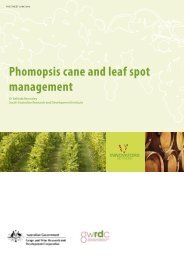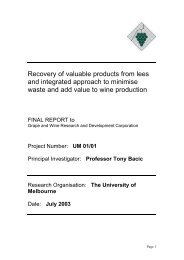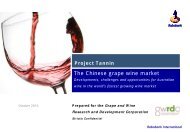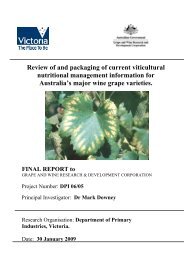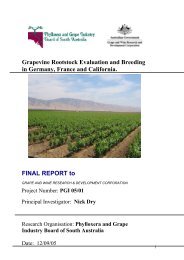Identification of the major drivers of 'phenolic' taste in ... - GWRDC
Identification of the major drivers of 'phenolic' taste in ... - GWRDC
Identification of the major drivers of 'phenolic' taste in ... - GWRDC
Create successful ePaper yourself
Turn your PDF publications into a flip-book with our unique Google optimized e-Paper software.
AWRI: <strong>Identification</strong> Of The Major Drivers Of ‘Phenolic’ Taste In White W<strong>in</strong>es<br />
8.5.2 Phenolic Measures<br />
Absorbances <strong>in</strong> <strong>the</strong> 230 to 430 nm range spectra <strong>of</strong> <strong>the</strong> 2010 w<strong>in</strong>es are shown <strong>in</strong> Figure 8-3. To simplify<br />
<strong>the</strong> figures, only duplicate w<strong>in</strong>es with <strong>the</strong> lowest and highest phenolic composition are shown. They are<br />
typical <strong>of</strong> white w<strong>in</strong>es <strong>in</strong> hav<strong>in</strong>g local maxima at 265–280 nm, represent<strong>in</strong>g phenolic acids as well as<br />
flavanols, and at around 325 nm represent<strong>in</strong>g hydroxyc<strong>in</strong>namic acids (HCA’s) and grape reaction<br />
products (2-S-glutathionyl caftaric acids and some o<strong>the</strong>r analogues). The absorbance patterns <strong>of</strong> w<strong>in</strong>es<br />
produced <strong>in</strong> <strong>the</strong> subsequent v<strong>in</strong>tage were similar (Figure 8-4). Individual values <strong>of</strong> Somers’ measurements<br />
are listed <strong>in</strong> Appendix B, Table B-6 and Table B-10 and are shown <strong>in</strong> Figure 8-5 (2010 w<strong>in</strong>es) and Figure<br />
8-6 (2011 w<strong>in</strong>es).<br />
The free run treatment represents a logical standard to which to compare o<strong>the</strong>rs as it is <strong>the</strong> most widely<br />
used method <strong>of</strong> white w<strong>in</strong>e production.. A percentage deviation from <strong>the</strong> free run w<strong>in</strong>es for total<br />
Phenolics and total HCA are given <strong>in</strong> Figure 8-7. Whole bunch pressed w<strong>in</strong>es from all three varieties had<br />
much less phenolic material compared to free run, and maceration resulted <strong>in</strong> much higher values. The<br />
HCA’s <strong>of</strong> <strong>the</strong> light and heavy press<strong>in</strong>gs are only slightly higher <strong>in</strong> Chardonnay and Riesl<strong>in</strong>g but <strong>the</strong> HCA<br />
<strong>of</strong> Viognier was 20% lower.<br />
The hyperoxidised w<strong>in</strong>es represented a probable extreme. Here, <strong>the</strong> musts were subjected to an excess <strong>of</strong><br />
oxygen result<strong>in</strong>g <strong>in</strong> <strong>the</strong> consumption <strong>of</strong> most <strong>of</strong> <strong>the</strong> phenolic substrates. In typical commercial practice <strong>of</strong><br />
hyperoxidation, not as much oxygen is used as <strong>in</strong> this experimental trial and this may result <strong>in</strong> residual<br />
phenolics.<br />
Naturally occurr<strong>in</strong>g glutathione <strong>in</strong> grapes acts as an antioxidant by react<strong>in</strong>g with o-qu<strong>in</strong>ones to form GRP,<br />
thus prevent<strong>in</strong>g fur<strong>the</strong>r oxidation. Hyperoxidation <strong>of</strong> both free run and press<strong>in</strong>gs juices reduced total w<strong>in</strong>e<br />
phenolics and total w<strong>in</strong>e HCA’s <strong>of</strong> all three varieties. The relative decreases <strong>in</strong> total phenolics and total<br />
HCA <strong>of</strong> w<strong>in</strong>e follow<strong>in</strong>g juice hyperoxidation compared with before treatment are given <strong>in</strong> Figure 8-8.<br />
Hyperoxidation <strong>of</strong> free run juice reduced <strong>the</strong> total phenolics <strong>of</strong> Viognier w<strong>in</strong>es <strong>the</strong> most and Chardonnay<br />
w<strong>in</strong>es <strong>the</strong> least. On <strong>the</strong> o<strong>the</strong>r hand, <strong>the</strong> decrease <strong>in</strong> total phenolics after hyperoxidation <strong>of</strong> press<strong>in</strong>gs was<br />
less pronounced for Viognier than <strong>the</strong> o<strong>the</strong>r two varieties.<br />
The decrease <strong>in</strong> HCA <strong>of</strong> hard press<strong>in</strong>gs is very similar for all varieties suggest<strong>in</strong>g that natural<br />
preservatives such as glutathione have already been pressed from <strong>the</strong> grape flesh and do not provide any<br />
protection to press juice.<br />
73




